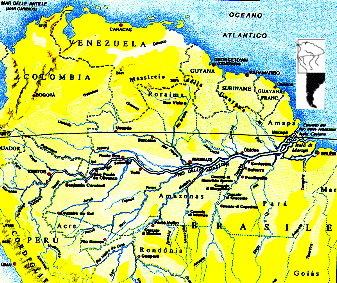It is the symbol of the veins of the planet, the third biggest river on earth which crosses the south-American continent from west to east. It rises in the Peruvian Andes at 5,600 metres above sea level in the Nevada Mismi and crosses Peru, Colombia and Brazil to finally pour into the Atlantic Ocean after a journey of 6,280 km.
The Amazon crosses the biggest forest in the world, the earth's biggest lung, contributing to its irrigation and nourishment.

The route of the Amazon traced on the map
The Amazon crosses the biggest forest in the world, the earth's biggest lung, contributing to its irrigation and nourishment. Its name changes several times during its long trip: from Apurimac when it rises in Peru to Ene, Tambo, Ucayali and finally Marañon. It is only on the border of Colombia that it becomes the Amazonian Rio but once in Brazil it is known as the Solimoes as far as Manaus only to change back to the Amazonian Rio near the mouth.
During its long journey its flowing waters grow, fed by the various tributaries of Peru, Colombia, Venezuela, Guyana and Surinam. Some of these, such as the Madeira and Purus, are longer than the Ganges. The Rio Negro which passes through Manaus, has a width of 50 km and when it joins the Solimoes its waters are over 70 metres deep. For around 80 km the waters of the two rivers are quite separate and distinct in their colours - one dark brown humus, the other a light, muddy colour.
But this great river has a slow current since, despite the distance of 4,000 km, there is only a very slight drop of around a hundred metres from Iquitos in Peru to the river mouth. This means that in the spring, with the alignment of the Earth, Sun and Moon, there is an enormous tide, what the Amazonian Indians call "Pororoca", a wave 5 metres high which bursts up the river from the sea for many kilometres.
Everything changes during the rainy season. From November to June the water level rises by 10 to 30 metres depending on the amount of rain and the area. A sixth of the basin disappears underwater: this is called the "Varzea", an area of 500,000 square kilometres, the same size as Spain.
However, the Amazon displays all its strength at the end of its journey: an enormous quantity of water, over 200,000 cubic metres per second, pours into the Atlantic Ocean carrying the river's fresh waters for hundreds of kilometres out to sea.
